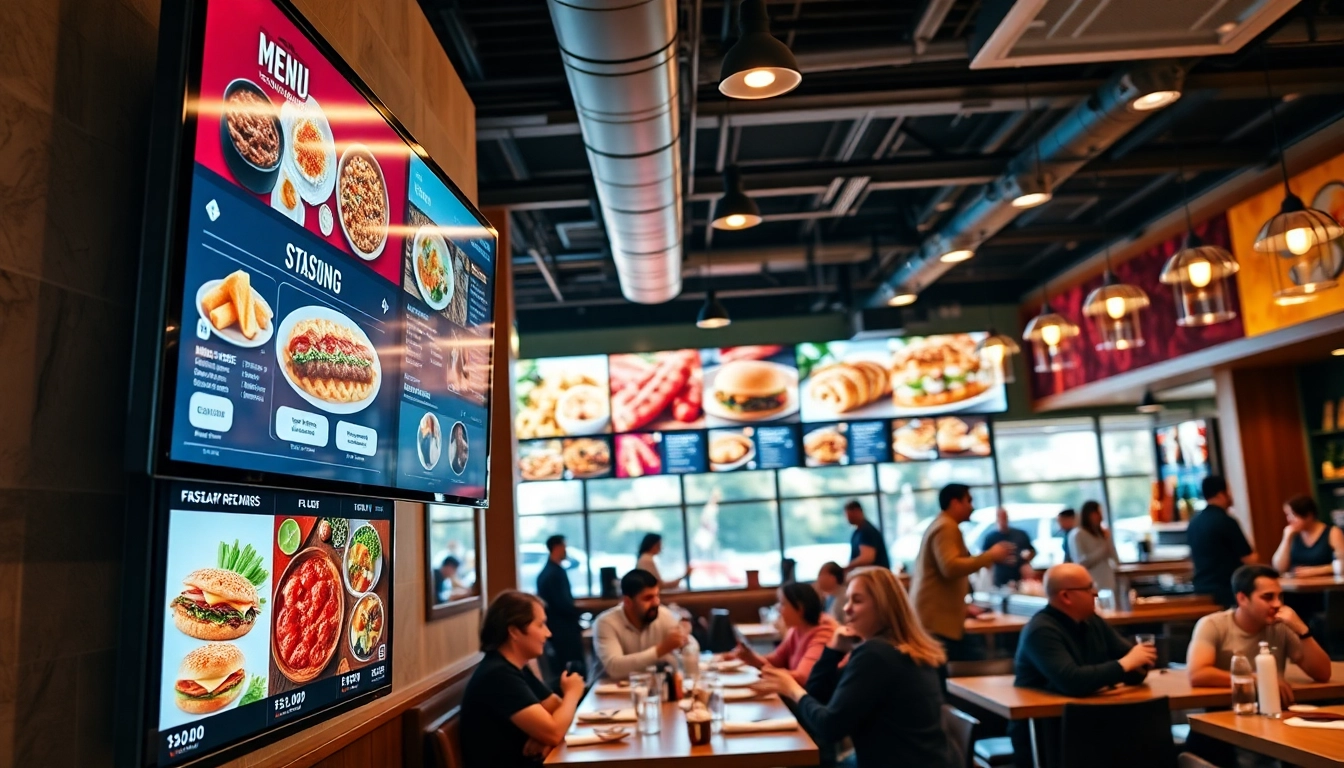1. Understanding Digital Signage for Restaurants
1.1 Definition and Purpose
Digital signage refers to the use of digital displays to convey content, advertising, and information to customers in real-time. In the restaurant industry, digital signage serves as a versatile communication tool that enhances customer experience by providing dynamic visual content. These displays can include LCDs, LED screens, or projection-based systems, allowing establishments to share menus, promotional material, and engaging multimedia presentations. The primary purpose of digital signage in restaurants is to create an engaging ambiance, manage customer orders efficiently, and ultimately drive sales.
1.2 Benefits of Digital Signage
The advantages of implementing digital signage in restaurants are multifaceted. Here are some of the most significant benefits:
- Enhanced Customer Engagement: With visually appealing content, digital signage captures attention and keeps customers informed about specials, events, or new menu items.
- Efficiency in Menu Updates: Digital displays allow for quick and easy updates, ensuring that menus reflect real-time changes in availability or pricing without the need for printing new materials.
- Increased Sales: Dynamic content, such as high-quality images of food and limited-time offers, can encourage impulse purchases and boost overall sales.
- Cost-Effectiveness: Over time, the elimination of printing costs and promotional materials typically outweighs the initial investment in hardware and software.
- Improved Customer Experience: Engaging visuals such as videos and animations can enhance the dining atmosphere, promoting a positive experience for diners.
1.3 Common Applications in Restaurants
Digital signage can be applied in various ways in restaurant settings, including:
- Menu Boards: Digital menu boards display the restaurant’s offerings, enabling easy updates and dynamic content presentation.
- Promotional Displays: Highlighting seasonal specials, discounts, and offers can be effectively achieved through rotating signage.
- Customer Feedback Screens: Soliciting real-time feedback enhances customer interaction and fosters a sense of importance for patrons.
- Event Announcements: Digital displays can be used to promote upcoming events, happy hours, or live entertainment schedules, keeping guests informed and engaged.
- Wayfinding Solutions: In larger establishments, digital signage can assist customers in navigating through the premises, ensuring a seamless experience.
2. Choosing the Right Digital Signage Solutions
2.1 Hardware and Software Considerations
Selecting appropriate hardware and software is crucial for successful implementation. Hardware choices include displays of varying sizes, based on space availability and viewing distances, as well as media players that manage the content shown. Software options include cloud-based content management systems that facilitate easier updates and scheduling from anywhere. Ensure compatibility between hardware and software, and consider future scalability when choosing digital signage solutions.
2.2 Display Types and Locations
Different types of displays serve various purposes, including:
- LED Displays: Known for their brightness and outdoor visibility, practical for establishments with windows or outdoor dining areas.
- LCD Screens: More common indoors, offering high resolution suitable for detailed visuals and menus.
- Touchscreen Displays: Allow customers to interact with the menu or features, enhancing engagement and providing self-service options.
Positioning the displays is equally important. High-traffic areas such as entrances, waiting areas, and queues are ideal for capturing attention, while more intimate settings might benefit from strategically placed smaller displays that enhance customer experience without overwhelming them.
2.3 Content Management Systems
A robust Digital signage for restaurants requires an efficient content management system (CMS) that enables operators to manage and customize content with ease. Look for features such as:
- User-friendly Interface: Simplifying the process of uploading, scheduling, and managing content.
- Remote Access: Allowing for updates and changes from any location, which is crucial for multi-location businesses.
- Scheduling Capabilities: Enabling content to be displayed at specific times or days, optimizing promotional effectiveness based on traffic patterns.
- Template Options: Providing pre-designed templates that can be customized for ease of use.
3. Creating Compelling Content for Digital Signage
3.1 Design Principles for Effective Displays
Design is key to ensuring that digital signage captures attention while conveying information effectively. Consider these principles:
- Clarity and Readability: Use legible fonts and maintain appropriate sizes; ensure that text is easily readable from a distance.
- Color and Contrast: Utilize contrasting colors to emphasize important content while ensuring the overall design aligns with the restaurant’s brand identity.
- Image Quality: High-resolution images of food can be persuasive, tempting customers with mouth-watering visuals.
- Simplicity: Avoid cluttered layouts; prioritize key information and visuals to avoid overwhelming viewers.
3.2 What to Include: Menus, Promotions, and More
Effective content should incorporate a mix of items that draw attention and facilitate decision-making:
- Menus: Clearly highlight the core offerings, including descriptions, images, and pricing, ensuring easy navigation.
- Promotions: Flashing or rotating promotions can drive impulse purchases, consequently increasing sales and engagement.
- Customer Testimonials: Positive feedback, displayed prominently, can enhance credibility and encourage new customers to try the restaurant.
- Social Media Integration: Encourage patrons to engage on social media by showcasing user-generated content or running campaigns that promote sharing experiences.
3.3 Tips for Dynamic Content Updates
Maintaining fresh content is essential for keeping customers engaged. Use these strategies:
- Regular Updates: Schedule content refreshes weekly or monthly to coincide with changing menus or promotions.
- Seasonal Themes: Tailor content to reflect seasonal changes, holidays, or special events, enhancing relevancy.
- Feedback Loop: Analyze which content features generate positive customer response and adapt based on perceptions.
- Visual Variety: Mix different types of content, such as videos and slideshows, to prevent monotony and keep customers engaged.
4. Measuring the Impact of Digital Signage
4.1 Key Performance Indicators
Measuring the effectiveness of digital signage is vital to understanding its impact on your restaurant. Some essential key performance indicators (KPIs) to track include:
- Sales Growth: Monitoring sales before and after signage implementation can reveal direct impacts.
- Customer Dwell Time: Analyzing how long customers spend viewing displays can provide insight into engagement levels.
- Menu Item Popularity: Tracking the sales of specific items highlighted on digital signage can help assess effectiveness.
4.2 Customer Feedback and Engagement Metrics
In addition to sales data, customer feedback plays a pivotal role in evaluating the sign’s impact:
- Surveys and Polls: Conducting surveys or polls can enable restaurants to gauge customer satisfaction and preferences regarding displayed content.
- Social Media Engagement: Monitor mentions, likes, and shares relating to the restaurant, especially posts featuring digital signage content.
- In-store Observations: Directly observing customer interactions with signage can yield qualitative insights into effectiveness.
4.3 Return on Investment Analysis
Calculating ROI for digital signage involves comparing costs to benefits. Consider factors such as:
- Initial Costs: The expense of hardware, software, installation, and training.
- Operational Savings: Savings from decreased printing materials and labor costs for updating physical menus.
- Increased Revenue: Increment in sales attributable to enhanced customer engagement and responsiveness.
5. Best Practices for Implementation
5.1 Staff Training and Preparation
Effective implementation of digital signage hinges on employee competency.
Consider the following steps for training staff:
- Hands-on Workshops: Provide practical sessions to familiarize staff with systems and ensure comfort with operations.
- Comprehensive Resources: Offer manuals or online guidance detailing systems functionality and troubleshooting steps.
- Continuous Training: Regularly update training methods to adapt to changes in technology or updates.
5.2 Maintenance and Troubleshooting
Regular maintenance is crucial to ensure signage systems are functioning optimally:
- Regular Checks: Routine inspections of hardware and software will help identify and mitigate problems before they escalate.
- Monitoring Systems: Implement remote monitoring tools to swiftly address any outages or technical issues.
- Technical Support: Have access to support services to assist with any unforeseen issues encountered post-implementation.
5.3 Future Trends in Digital Signage
The landscape of digital signage is evolving rapidly. Future trends may include:
- Artificial Intelligence: AI-driven content customization based on customer preferences and behaviors could revolutionize how restaurants engage their patrons.
- Augmented Reality: AR technology may allow customers to visualize menu items in real environments or provide immersive experiences in restaurants.
- Sustainability Focus: Eco-friendly digital signage solutions, such as lower power displays and sustainable materials, may become increasingly important to consumers.












Leave a Reply